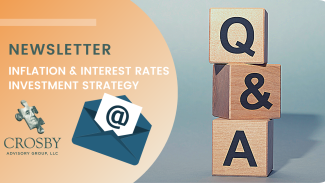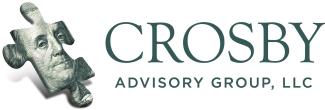
What has changed since December
Summarizing last week’s trading, the large-cap S&P 500 lost 4.77%, the Nasdaq 100 lost 6.06%, and the Dow Jones Industrial Average lost 3.68%.
Financial Scorecard
If you are interested in beta testing our new financial scorecard follow the link below, we will not share any of the data you choose to share with us. Results are available only on weekdays
Dynamic Growth Podcast
Listen & Subscribe to our podcast Dynamic Growth where we discuss what we see in the market and broader topics around personal growth and personal finance.
Weekly Wisdom
“If you aren’t willing to own a stock for ten years, don’t even think about owning it for ten minutes."
-Warren Buffet
What is Ailing the Stock Market? -Nate Crosby
What is the difference between companies like Apple, Microsoft, and Nvidia 3 months ago and today? On a company level, not much. They are still the same innovating companies with products of which consumers can’t get enough. What has changed is the mood. The number one driver of uncertainty in the market today is looming interest rate hikes. We know they are coming, and we have prepared for them. The uncertainty lies not in the inevitability, but rather to what extent?
As 2021 was ending, the Federal Reserve, which is the central bank and monetary authority in the United States, telegraphed that it could see 2-3 rate hikes in 2022 to try and rein in inflation, which the Bureau of Labor lists at 7.0%. If that prediction were to hold true, then we would anticipate the base Fed Fund Rate to be at 1% by the end of 2022. That is still historically cheap money.
However, since then there has been speculation made that the Federal Reserve is understating the inflation problem and that they may have to raise interest rates more than 3 times and potentially at a faster pace than originally communicated. Goldman Sachs predicts 4 interest rate hikes and JP Morgan’s CEO Jamie Dimon recently said we could see as many as 7 rate hikes this year.
While we don’t believe there is any way the Federal Reserve could make 7 rate hikes without sinking the economy, we do know the actual number of rate hikes we will see this year is still unknown. I received a call from a long-time client yesterday that asked me two questions that I think are relevant to this newsletter.
-
“Why do stocks care what inflation and interest rates do?” Great question. Stocks don’t care that much about inflation. In fact, stocks are a great way to protect against inflation because they historically appreciate over time faster than the inflation rate. Companies pass the cost of inflation onto the consumer, so through price increases, businesses are able to maintain their profit margins. What stocks do care about is interest rates. For the past several years, interest rates have been at or near all-time lows. Cheap money allows businesses to borrow and expand. However, when interest rates rise, servicing that debt can reduce a company’s profit margin. For example, if Crosby Advisory took out a loan in 2019 to expand its operations, and still has a balance on that loan today when interest rates go up soon, Crosby Advisory would pay higher interest on that loan which could reduce our cash flow. So, companies don’t worry about inflation as much as interest rates. Cheap money is good for business, expensive money makes it harder to grow.
So why are interest rates and inflation often discussed in the same sentence? The Federal Reserve “attempts” to use interest rates to control the economy. When the economy is in danger, it lowers interest rates to make the cost of doing business cheap, so the economy can expand, and when the economy is running too hot and inflation is a problem, it raises interest rates to slow down growth.
- “What specifically are you doing to my portfolio to prepare?” The Federal Reserve telegraphed future interest rate hikes in 2021. Long duration bonds which are most negatively affected by interest rate increase have been moved to short duration bonds. Our gold position was increased by 1%. Consumer staples, which are typically defensive and a proxy for inflation (because they sell things that are increasing due to inflation) have been added to most of our models. Growth stocks have been trimmed slightly and replaced with dividend-paying value stocks. However, overall, the strategy is the same. In the long-term owing solid investments wins out. Whether through funds, ETFs, or individually, when investing in stocks, our goal is to own the world’s most successful companies. If we continue to do that, I believe appreciation will take care of itself.
Notes on Volatility
This market is volatile. It's the swings up and down are almost nauseating if you were to monitor your portfolio on a daily basis (which we do). I remember reading somebody's comment on investment strategy and they made a very interesting point. There has been a plethora of books, articles, textbooks, publications for investment strategy, written by some of the world's most successful investors from both the fundamental side and the technical side. Usually, the author will state their investment strategy in great detail. So why isn't everybody a successful investor? I wish I knew who wrote it so I could quote them, but the person hypothesized that some strategies are too complex and when people try to replicate those strategies they lack the skills or resources to do so successfully, or other strategies are quite simple but people lack the emotional strength to see them through when times get tough.
“Our favorite holding period is forever”
-
Warren Buffett
The Buy and Hold strategy is a tried and true way to build wealth, do extensive research on a company that has a long track record of increasing revenue, wide economic moat, and high margins, in a sector that is growing, and has a healthy balance sheet with good management. Then monitor to make sure those things don't change significantly, but for the most part let the swings of the market happen and just ride the waves.
Yes, the market is volatile, but rest assured we don't speculate. We only buy companies that fit these characteristics so we can ride these waves with minimal anxiety. It's not fun by any means, but it's an opportunity of which to take advantage.
Let's look at stocks that have fallen and compare that to the underlying performance of the company.
Paypal: You would have to go back to June 19th, 2020 to buy shares at the current price. Since June PayPal has increased revenue by 27.8% and increased earnings by 90.8%
Shopify: You would have to go back to June 18th, 2020 to buy shares at the current price. Since June Shopify has increased revenue by 102% and increased earnings per share by roughly 44x.
You can see this across our watchlist, I can go on for a while but these are two dramatic examples. So what will turn this market around? I think a big factor is we haven't seen earnings from a lot of the companies that have driven this market up for the past two years.
Microsoft, Next Era Energy, Abbott Labs, Kimberly Clark, Crown Castle International, Tesla, Apple. McCormick, Sherwin Williams, and Caterpillar are all companies that report earnings next week. Positive earnings will give us a breather from the descent or give us an opportunity to capitalize on an inefficiency.
Exam Free Coverage Option
Last week a client said they finally realized they needed life insurance, but they were not comfortable with needles in the event of a life insurance exam. No problem, if you are relatively healthy, we have access to companies that will offer coverage without a medical exam. Typically, if you are looking for coverage amounts over $250,000 it is more efficient cost-wise to go through full underwriting, but for those looking to get a few hundred thousand dollars of coverage in place quickly, we have needle-free options! 😊These products are sold through our insurance agency NMD Insurance.
This newsletter is for informational purposes and should not be taken as direct investment advice without understanding your goals objectives. Investing involves risk including the potential loss of principal. Carefully consider all risk and fees before investing. Crosby Advisory Group, LLC is a registered investment advisor in Ohio and Florida. Insurance products are sold and serviced through our insurance agency, NMD Insurance. Employees of Crosby Advisory and NMD Insurance may own investments mentioned in this newsletter.
Follow us on Social Media
Facebook: Crosby Advisory Facebook Instagram: Crosby Advisory Instagram Youtube: Crosby Advisory Youtube
--
Nate M. Crosby, CRPC
Crosby Advisory Group, LLC
www.crosbyadvisory.com
Phone: 855.496.0770
419.496.0770
Wealth Accumulation, Retirement Income Planning, Insurance
Listen to our podcast Dynamic Growth Here. New episodes release every Monday.
CONFIDENTIALITY STATEMENT
Both Nate Crosby and Crosby Advisory Group, LLC intend that this message be used exclusively by the intended addressee. This message may contain information that is privileged or otherwise protected from disclosure by applicable law. If you are not the intended addressee, please delete the message and contact Nate Crosby at the above location.
Disclaimer
This newsletter is for informational purposes and should not be taken as direct investment advice without a consultation. Investing involves risk including the potential loss of principal. Understand all risks and fees before investing. Crosby Advisory Group, LLC is a registered investment advisor in Ohio and Florida. Employees of Crosby Advisory may own investments mentioned in this newsletter. Insurance products are sold and serviced through Crosby NMD Insurance.

